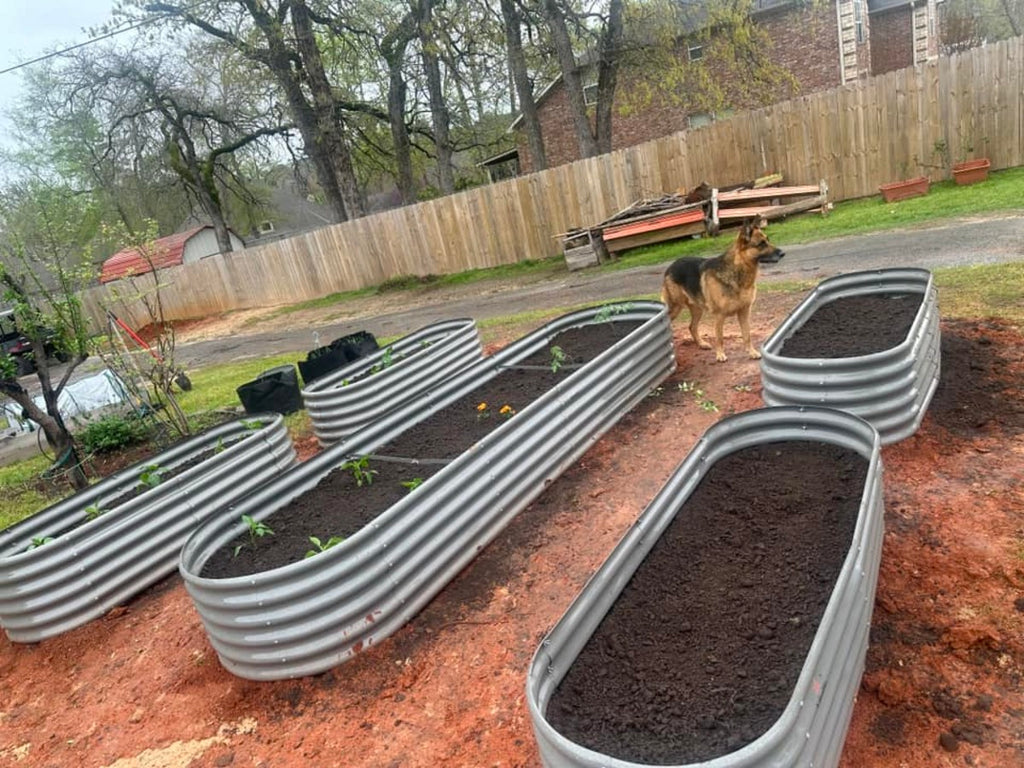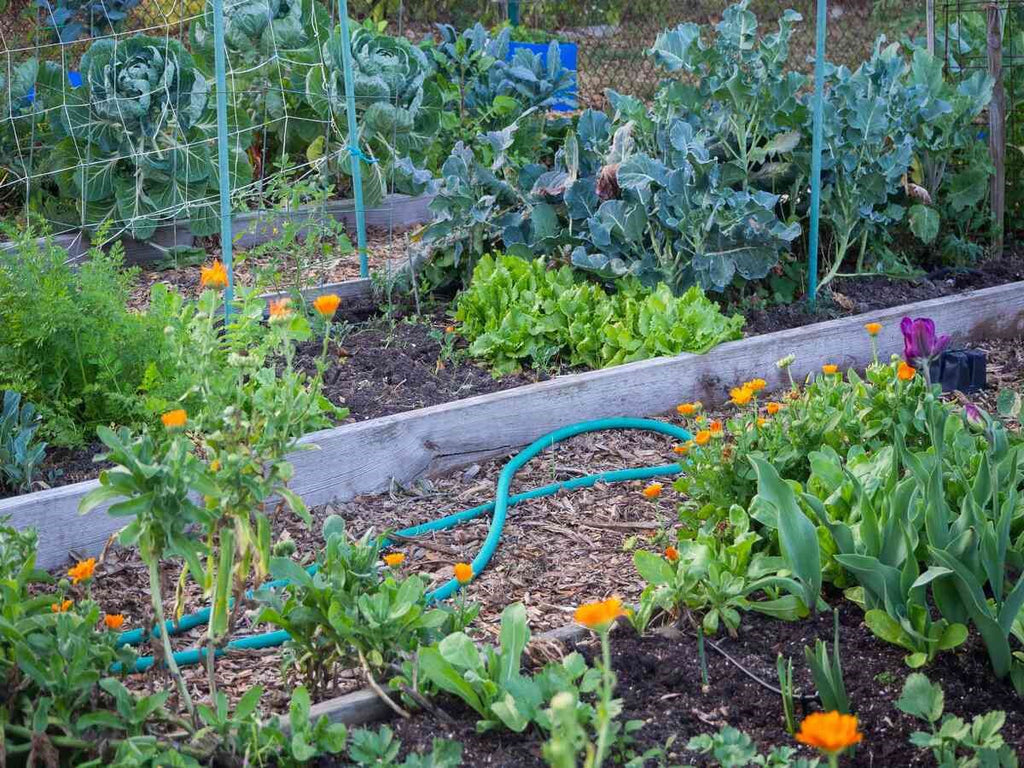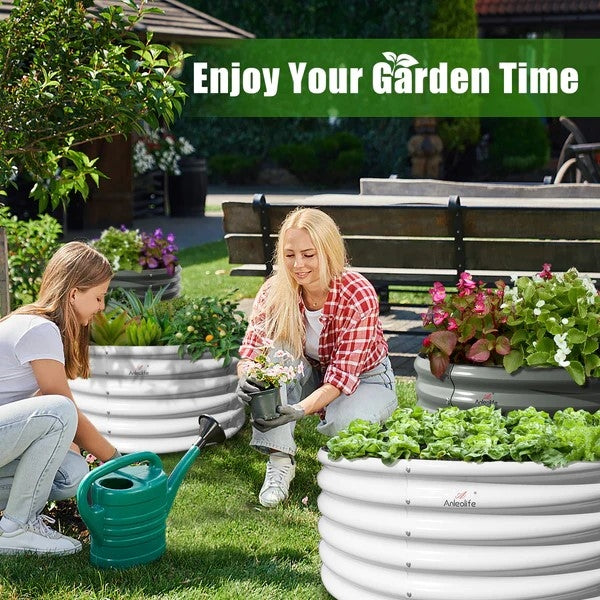Succession planting is the practice of planting new crops as others are harvested or as the seasons change. This method maximizes yield and extends the harvest period.
Transitioning your garden from spring to summer offers a fresh set of challenges and opportunities. Raised bed planting, with its controlled environment, is particularly well-suited for this transition.
Read on to grasp 10 effective strategies to ensure a seamless changeover from spring to summer:

1. Transition Timely
Effective timing is the backbone of successful gardening, especially when transitioning between seasons. Begin with a clear understanding of the growth cycle and harvest period of your spring crops. Most spring crops, like lettuce, radishes, and peas, have a relatively short growth cycle, typically ranging from 30 to 60 days. This means you should be ready to replace them as soon as they reach maturity, avoiding any lapse in productivity.
To ensure a timely transition, monitor your plants closely as they approach the end of their cycle. Once they begin to show signs of decline, such as yellowing leaves or a halt in growth, it's time to act. Removing these plants promptly prevents them from exhausting the soil's nutrients, which are crucial for the success of your upcoming summer crops.
Additionally, consider the specific needs of the plants you intend to grow next. For instance, if your summer crops require warmer soil, time their planting for when the spring crops are done, and temperatures have reliably increased. This strategic overlap ensures your garden remains vibrant and productive, with no wasted space or time.
2. Prepare the Soil
Once your spring crops have been cleared, focus on preparing the soil for its next occupants. Start by removing all remnants of the previous plants, including roots and leaves, which can harbor pests or diseases. This cleanup is crucial for preventing the transfer of problems from one season's plants to the next.
Next, enrich the soil. The addition of fresh compost and organic matter is non-negotiable. Compost provides a rich array of nutrients and improves soil structure, making it more conducive to plant growth. A general guideline is to add about 2 to 4 inches of compost to the top layer of soil. This not only replenishes nutrients but also enhances moisture retention and drainage-critical factors for heat-loving summer crops.
Consider conducting a soil test to determine specific nutrient deficiencies. This allows you to tailor your soil amendments to meet the exact needs of your summer plants, ensuring they get a strong start.
3. Choose Summer Plants
Selecting the right plants for the summer season is a nuanced process. It involves more than just choosing what you like; it requires consideration of how well each plant will adapt to the hot summer conditions of your specific location.
Begin by identifying varieties known for their heat tolerance and ability to thrive in longer daylight hours. Classic summer crops include tomatoes, peppers, squash, and cucumbers. However, local climate, including average temperatures and humidity, should guide your final selections.
Diversity is your ally. Incorporating a range of plant types-such as root vegetables (like carrots and beets), leafy greens (such as Swiss chard and kale), and flowering plants (like marigolds and zinnias)-can lead to a healthier garden ecosystem. This variety not only combats pest infestation by making it harder for pests to spread but also promotes beneficial insects and soil health.
Moreover, consider the water needs of your selected plants. Some, like cucumbers and zucchini, require consistent moisture, while others, such as lavender and rosemary, are more drought-tolerant. Balancing these needs can help you create a more sustainable and water-efficient garden layout.
4. Adopt Planting Techniques for a Productive Garden
Effective planting techniques can dramatically improve the yield and health of your garden. Here's how to apply each method for optimal results:
- Direct Seeding:This method is straightforward and cost-effective, ideal for robust, fast-growing plants like beans and cucumbers. Plant seeds at the depth and spacing recommended on the seed packet, considering the mature size of the plants. Direct seeding is best done after the last frost when the soil has warmed up, enhancing germination rates and early growth.
- Transplanting:For plants like tomatoes and peppers, starting with seedlings, whether homegrown or purchased, can extend the growing season. Begin by acclimatizing the seedlings to outdoor conditions through a process called hardening off. This involves gradually exposing them to outdoor temperatures and sunlight over a week. When transplanting, be gentle with the roots and plant at the appropriate depth-usually up to the first set of true leaves for tomatoes to encourage deeper root growth.
- Interplanting:This method involves planting a combination of different crops close together. By pairing fast and slow growers, you can harvest the quick-growing plants (like radishes) before the slower ones (like carrots) need more space. Mixing shallow with deep-rooted plants, such as lettuce with carrots, allows them to occupy different soil levels without competing for nutrients. Interplanting can also create a beneficial microclimate and improve soil conditions, as the varied canopy levels reduce soil moisture loss and keep weeds at bay.

5. Water Management
Proper water management is critical during the summer months. To conserve water and ensure deep watering:
- Schedule watering for early morning or late afternoon to minimize evaporation.
- Use soaker hoses or a drip irrigation system to deliver water directly to the plant roots, where it's most needed. This method is more efficient than overhead watering, which can lead to leaf diseases and wasted water.
- Mulch around plants to retain soil moisture and reduce watering frequency. A good rule of thumb is to provide your garden with 1 inch of water per week, but this may vary based on local conditions and soil type.
6. Pest and Disease Control
Warmer temperatures can increase the activity of pests and the spread of diseases. To manage this:
- Regularly inspect your plants for signs of stress, pests, or disease. Early detection is key to effective management.
- Employ natural predators like ladybugs for aphid control. Use barriers such as row covers to protect plants from insects.
- Practice crop rotation and proper sanitation, such as removing diseased foliage from the garden, to prevent the spread of pathogens.
- Opt for organic treatments when necessary, and always follow the application instructions carefully.
7. Mulching
Mulching is a simple yet effective technique to improve your garden's health and efficiency:
- Apply a 2-4 inch layer of organic mulch around your plants. This can be straw, shredded leaves, or wood chips.
- Mulch helps retain soil moisture, suppress weeds, and keep the soil cool.
- As organic mulches decompose, they add valuable nutrients back into the soil, enhancing its structure and fertility.
8. Continuous Harvest and Planting
Instead of planting all at once, distribute your plantings over several weeks or months. This method, known as "successive planting," allows for a consistent supply of produce rather than a single, overwhelming harvest.
Implement successive planting by:
- Spacing out seed sowing: Plant seeds of quick-maturing crops, such as lettuce or radishes, at two-week intervals. This provides a steady stream of produce throughout the season.
- Planting different varieties: Choose early, mid-season, and late-maturing varieties of the same crop. This extends the harvest period as each variety reaches maturity at different times.
- Replanting after harvest: Once a crop is harvested, replenish the soil and plant a new crop immediately. Consider planting a different type of crop to manage soil nutrients efficiently and combat pest cycles.
his approach not only enhances the productivity of your garden but also ensures a more balanced workload and a continuous supply of fresh vegetables.

9. Keep Records
Maintaining a garden journal is a crucial, yet often overlooked, aspect of gardening. Accurate records can transform your gardening practice by allowing you to learn from past successes and mistakes.
Your garden journal should include:
- Planting dates and varieties: Track what you plant and when, including the variety name and source.
- Weather conditions: Note temperature highs and lows, rainfall, and any unusual weather events.
- Pest and disease observations: Record any issues encountered, the affected plants, and how you addressed the problem.
- Harvest dates and yields: Keep track of when you begin harvesting each crop and how much you collect.
Over time, this journal becomes a personalized guide, helping you optimize planting times, choose the most successful plant varieties, and develop strategies to combat pests and diseases based on historical data.
10. Adapt to Change in the Garden
Adaptability is an essential trait for gardeners. Weather, pests, diseases, and other unforeseen factors can affect your garden's performance. Being observant and willing to adjust your practices in response to these challenges is crucial.
Adaptation strategies include:
- Changing watering schedules based on weather conditions and plant needs.
- Altering planting or harvest times in response to unseasonal weather patterns.
- Trying new plant varieties if current ones are not performing well.
- Implementing new pest control methods if existing measures are ineffective.
Remember, each gardening season is different. What works one year may not work the next. By staying flexible and open to learning, you can navigate the challenges and enjoy the rewards of a thriving garden.
Read More
- Anleolife Garden View: How to Build a Raised Garden Bed & Garden Boxes
- Tips from Anleolife Garden Bed: 11 Best Gardening Tools Ignored by Mos
- Anleolife Garden View: How To Decide A Best Location For Your Raised G
- A Concise Filling Approach as Reference – Anleolife Garden
- Can You Imagine Trees in Metal Raised Garden Beds? – Anleolife Garden

